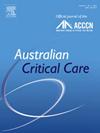Identification of Takotsubo syndrome in intensive care units: A scoping review
IF 2.7
3区 医学
Q2 CRITICAL CARE MEDICINE
引用次数: 0
Abstract
Objectives
The objective of this scoping review was to evaluate existing evidence on assessment and screening tools for Takotsubo syndrome (TTS) with a focus on understanding whether a clinical pathway tailored for intensive care unit (ICU) patients is warranted, given the high risk and complex presentation of Takotsubo syndrome in critically ill populations.
Review methods and data sources
This review followed the framework of Arksey and O'Malley. Searches spanned 10 databases, including MEDLINE, EMBASE, and CINAHL, plus grey literature, covering English-language studies on adults. The search strategy included Medical Subject Headings terms, keywords, Boolean operators, and truncations. We organised citations with EndNote (Clarivate Analytics, Philadelphia, PA, USA) and screened studies using Covidence, with eligibility confirmed by consensus.
Results
Thirty-two studies met the inclusion criteria, with publications ranging from 1990 to June 2024. Fourteen studies assessed electrocardiographic features to distinguish TTS from other cardiac conditions; 11 studies examined biomarkers with the potential for early detection of TTS. Five studies assessed echocardiographic markers for identifying transient left ventricular dysfunction associated with TTS. Two scoring systems, the International Takotsubo score and Platelets and Thrombosis in Sheba score, show potential for TTS diagnosis but lack validation specific to the ICU, limiting clinical utility. This review found that integrating distinctive electrocardiographic patterns and elevated biomarker ratios could provide valuable early indicators of TTS in intensive care settings. Echocardiographic parameters, including contrast imaging and wall motion score indices, could further support differentiation of TTS from other acute myocardial conditions in critically ill patients.
Conclusions
This review highlights gaps in ICU-specific TTS assessment practices, suggesting that developing a tailored clinical pathway, followed by validation, could support early recognition and management of TTS in ICU settings, enabling timely intervention and enhancing patient outcomes.
重症监护病房Takotsubo综合征的鉴定:范围综述
本综述的目的是评估Takotsubo综合征(TTS)评估和筛查工具的现有证据,重点是了解考虑到Takotsubo综合征在危重患者中的高风险和复杂表现,为重症监护病房(ICU)患者量身定制的临床途径是否有必要。综述方法和数据来源本综述遵循Arksey和O'Malley的框架。搜索跨越了10个数据库,包括MEDLINE, EMBASE和CINAHL,以及灰色文献,涵盖了成人的英语研究。搜索策略包括医学主题词、关键字、布尔运算符和截断。我们使用EndNote (Clarivate Analytics, Philadelphia, PA, USA)整理引文,并筛选使用covid - ence的研究,通过共识确认其合格性。结果符合纳入标准的研究32篇,发表时间从1990年到2024年6月。14项研究评估了心电图特征,以区分TTS与其他心脏疾病;11项研究检查了具有早期发现TTS潜力的生物标志物。五项研究评估了超声心动图标记识别与TTS相关的短暂性左心室功能障碍。两种评分系统,国际Takotsubo评分和示巴血小板和血栓形成评分,显示出TTS诊断的潜力,但缺乏针对ICU的验证,限制了临床应用。本综述发现,整合独特的心电图模式和升高的生物标志物比率可以为重症监护环境中的TTS提供有价值的早期指标。超声心动图参数,包括对比成像和壁运动评分指标,可以进一步支持危重患者TTS与其他急性心肌疾病的区分。本综述强调了ICU特定TTS评估实践的差距,提示开发定制的临床途径,然后进行验证,可以支持ICU环境中TTS的早期识别和管理,从而实现及时干预并提高患者预后。
本文章由计算机程序翻译,如有差异,请以英文原文为准。
求助全文
约1分钟内获得全文
求助全文
来源期刊

Australian Critical Care
NURSING-NURSING
CiteScore
4.90
自引率
9.10%
发文量
148
审稿时长
>12 weeks
期刊介绍:
Australian Critical Care is the official journal of the Australian College of Critical Care Nurses (ACCCN). It is a bi-monthly peer-reviewed journal, providing clinically relevant research, reviews and articles of interest to the critical care community. Australian Critical Care publishes peer-reviewed scholarly papers that report research findings, research-based reviews, discussion papers and commentaries which are of interest to an international readership of critical care practitioners, educators, administrators and researchers. Interprofessional articles are welcomed.
 求助内容:
求助内容: 应助结果提醒方式:
应助结果提醒方式:


